Jellyfish are fascinating marine creatures. Although they lack essential organs such as the heart and brain, the lack of bones in their anatomy makes them more unusual.
Scientists estimate that the number of jellyfish species exceeds 300,000, but the known ones are about 2,000.
While some species of jellyfish are harmless, others prey on aquatic animals and can harm you by stinging.
Before diving into the sea and enjoying the beauty of beaches in Florida, let’s learn about the types of jellyfish found there. This will help you protect yourself against harm.
We have researched and outlined eleven common jellyfish types in Florida, including their appearance, habitat, and sting severity.
Table of Contents
1. Box Jellyfish
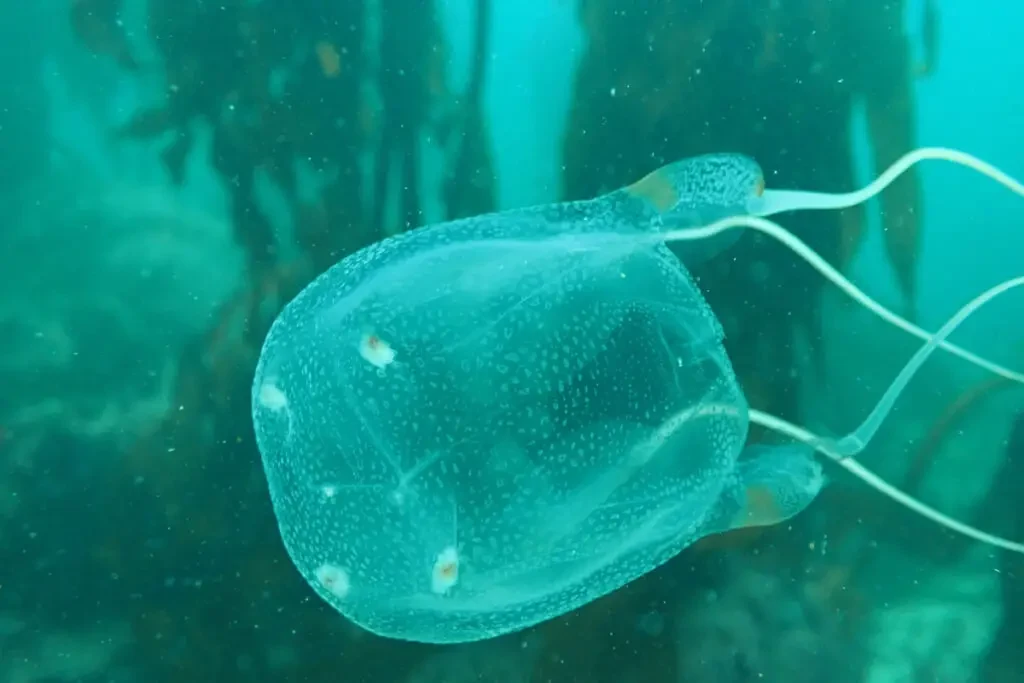
Also known as sea wasps, box jellies are blue. They have cubic bodies, hence the name box jelly.’
This jellyfish type has strong venom, which kills its prey instantly. It is always alert, with 15 tentacles measuring about 10 feet on each bell.
Box jellyfish feed on shrimp, crabs, and other aquatic animals. When moving, they can jet up to four knots through the water.
In addition, they have multiple eyes with advanced lenses, retina, and cornea. These features help it spot prey from all directions.
Box jelly venom is extremely potent. Therefore, avoid getting close when you spot one. The venom affects its victims’ skin, heart, and nervous system.
Their effect on humans is fatal. The victims die instantly from heart failure. And if you survive, you experience sharp pain and scars from their lethal sting.
2. Blue Button
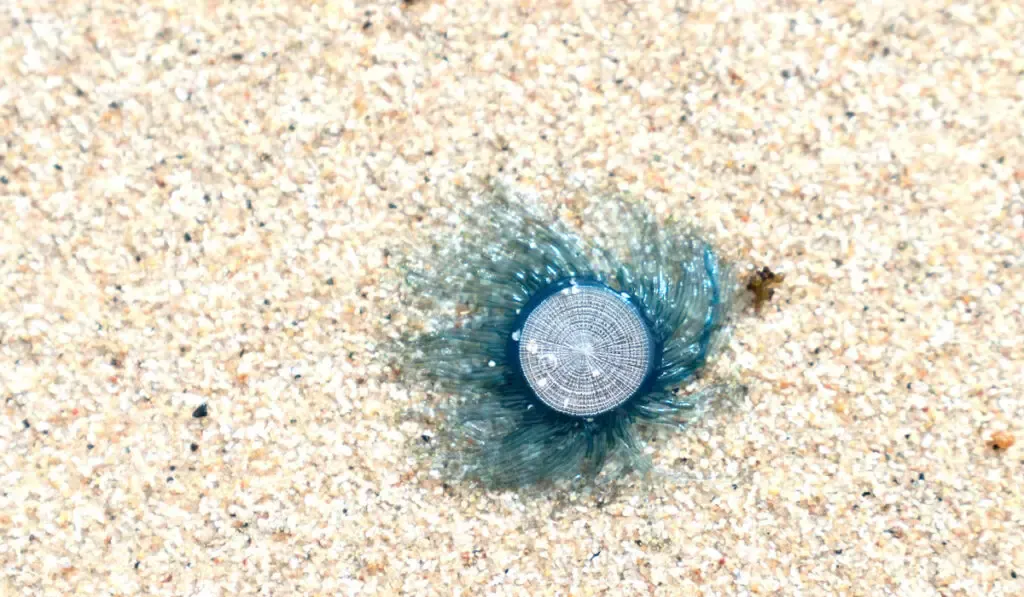
The blue button is a hydroid in the class Hydrozoa. They are also known as colonial animals.
Blue button jellies have small bodies measuring 1 inch in diameter. Their bodies have a golden-brown float at the center, surrounded by hydroids.
The hydroids are blue, yellow, or purple.
Although button jellies are not actual jellyfish, their tentacles and stinging cells earned them the same classification as jellies.
Blue buttons live in warm waters. You can spot them by their tiny bodies and colored hydroids.
Despite having stings, their venom is mild and only irritates. This makes them fall prey to other sea animals, such as slugs and snails.
3. Drymonema larsoni
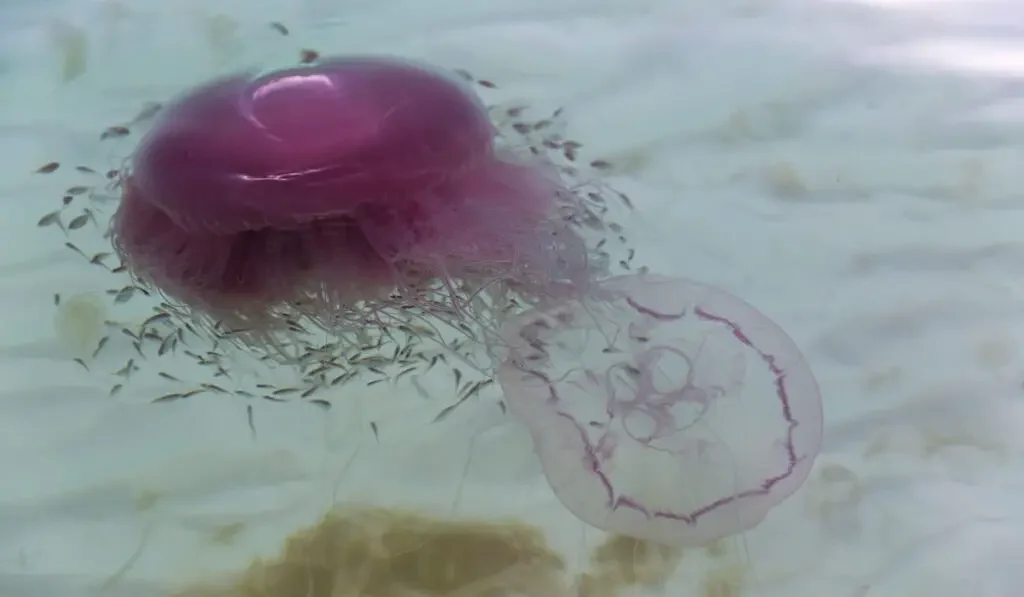
The Drymonema larsoni is commonly known as the pink jelly from its body color.
It feeds on other jellyfish and is, therefore, common in areas with many of them.
An adult pink jelly is about 67 inches long, 35.8 inches wide, and weighs 30–50 pounds. It can consume up to 34 jellies by trapping them in its tentacles.
The pink jelly venom is mild and rarely kills. If you suffer its sting, your skin may itch slightly with mild pain.
Pink jelly is less harmful to humans and more dangerous to other jellies, as it preys on them.
4. Portuguese Man o’ War
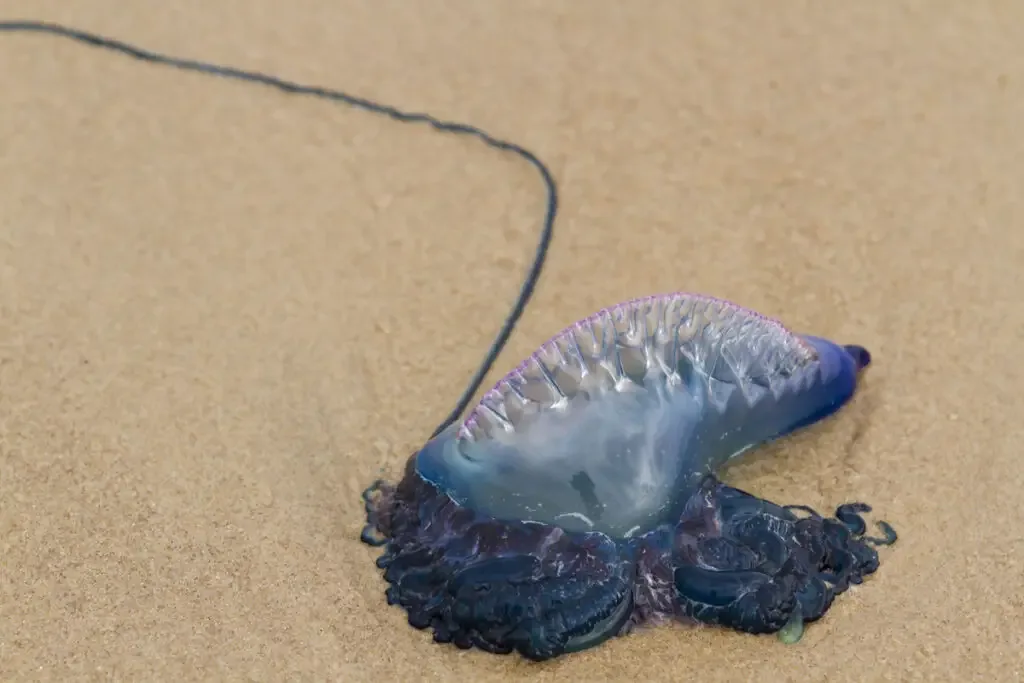
The Portuguese Man o’ War is the most complex and dangerous jellyfish.
If you wonder what makes it complex, here are some of its peculiar features.
- Large gas tail bladder with a vertical membrane
- Clusters of polyps about 118.1 inches long, each with stinging tentacles
- Potent venom where a single tentacle can kill fish and humans
- Digestive chemicals that liquefy its prey before absorbing it
- Can consume up to 120 larval fish in one day
This jelly appears in three colors: blue, violet, and pink.
Its body structure resembles the Portuguese warship, hence the name ‘Portuguese Man o’ War.’
If you spot this jelly, avoid contact because its venom is lethal, and it moves swiftly.
5. Moon Jellyfish
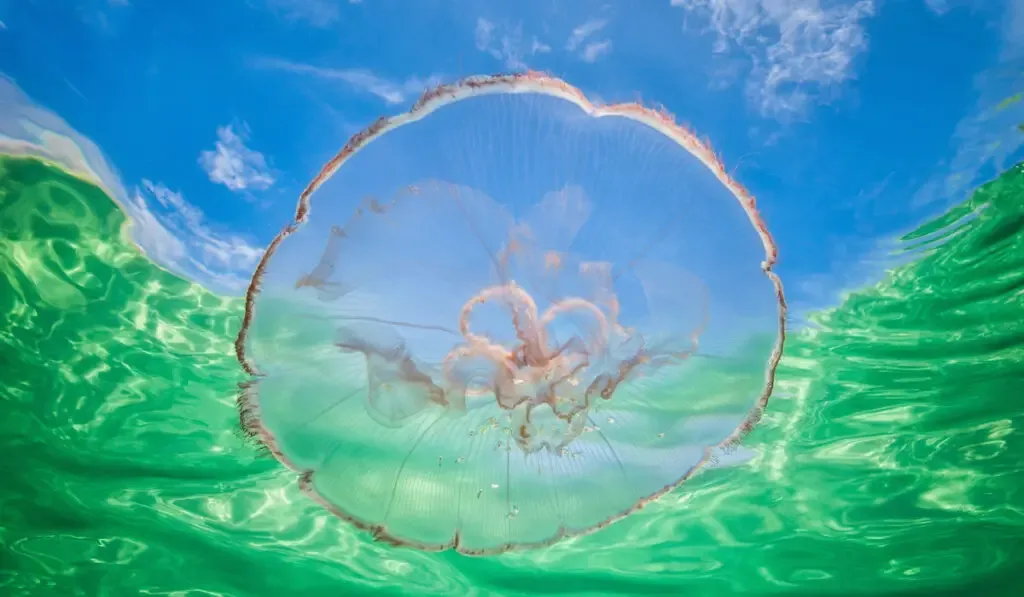
Moon jellyfish are translucent and live in cold and warm waters. They are medium-sized and feed on mollusks and plankton.
This jelly type moves by the ocean current and stays close to the water’s surface. They are social, so they move in groups called ‘smacks.’
Their tentacles are short and hairy. Short hair-like tentacles rim their oral arms, hanging from their bell center with mild venom.
Moon jellyfish look passive but have predatory characteristics. When plankton and other tiny sea animals touch their oral arms, they release venom through their tentacles to paralyze them before consuming.
With their high protein content, sunfish, seabirds, sharks, and other marine animals often prey on moon jellies.
6. By the Wind Sailor
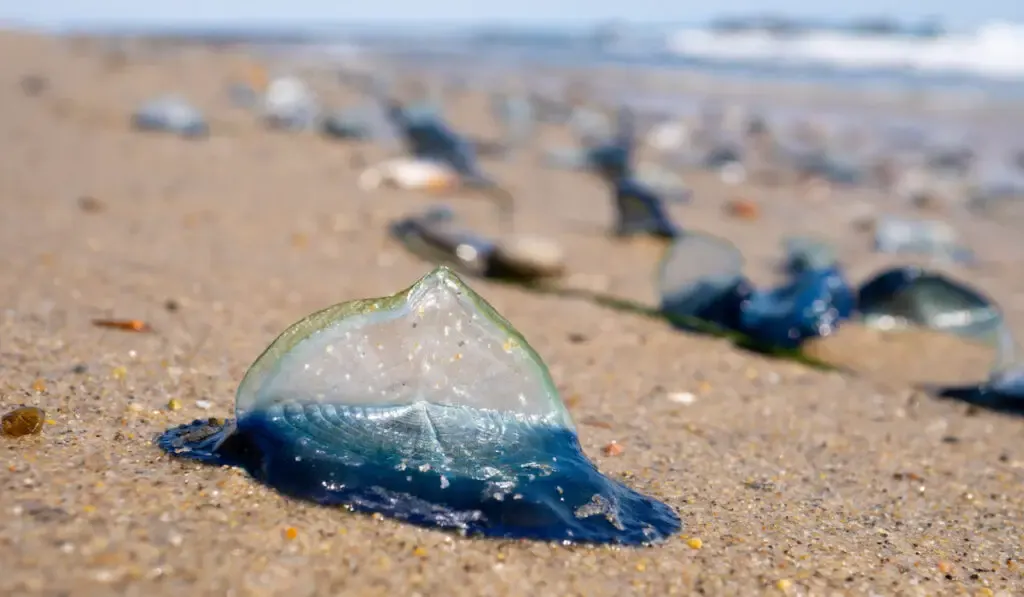
This colonial hydroid is not a true jellyfish, but its sail gives it the name ‘By the Wind Sailor’.
A colony of tiny animals makes up this hydroid, which moves by the sea current.
These sailors have stinging tentacles hanging from their oval, disc-shaped bodies. They appear in two colors: deep blue and purple.
Since they move by current, you will find them along the shores after stormy weather.
By-the-wind-sailor venom is mild to humans, but if you handle them and touch your eyes, they will irritate.
7. Sea Nettle
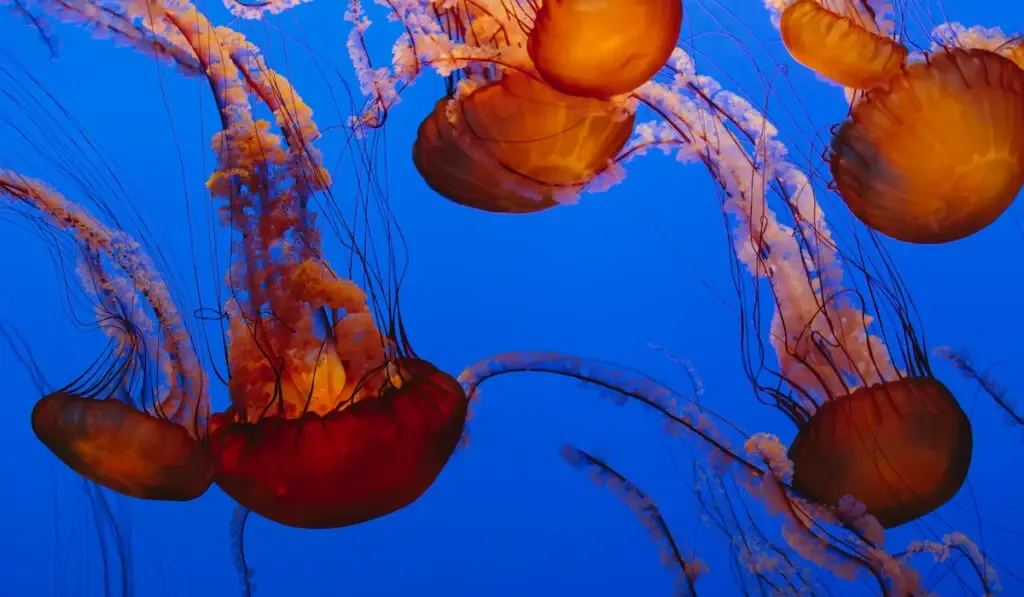
The sea nettle is a highly populous jellyfish due to its sexual and asexual reproduction. They are common in saline water and in bays.
This jelly has a saucer-shaped bell with four thick oral arms hanging at the margin.
The sea nettle jellyfish appears in varying colors, such as pink, red, maroon, and yellow. Whereas those in low salinity waters have a white bell, the ones in bays are pink, light gray, yellow, or clear.
A mature sea nettle has a 3.93-inch diameter and 1.97-inch height. They feed on other jellies by stinging them.
Despite their sting being mild, you can experience pain and allergic reactions from their sting.
8. Lion’s Mane
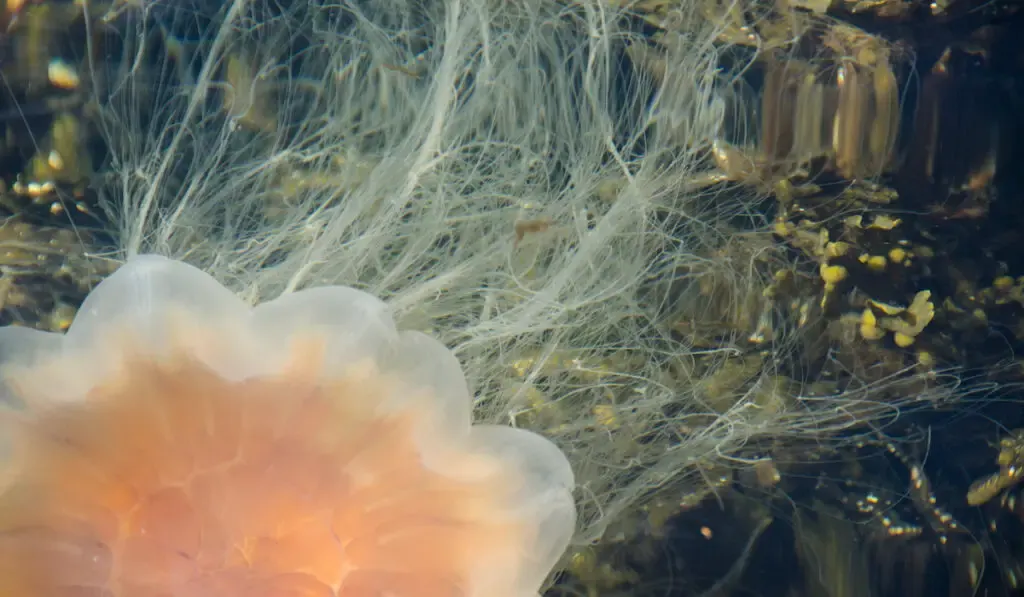
Lion’s mane jellyfish have long flowing tentacles with a powerful sting, hence the name lion’s mane.
Stinging cells covering the tentacles paralyze their prey before consuming them.
The lion’s mane is translucent brown with a thick, dark red mane. The oral arms under the bell are brown.
This jellyfish type adapts well to warm waters. They are common along coasts during summer months.
Another unique feature of the lion’s mane is its tentacles. They can sting you even when detached from the jellyfish.
If you are walking along the shore, be careful not to step on broken tentacles. They are equally dangerous.
Although their stings are sharp and painful, they are not fatal.
9. Cannonball Jellyfish
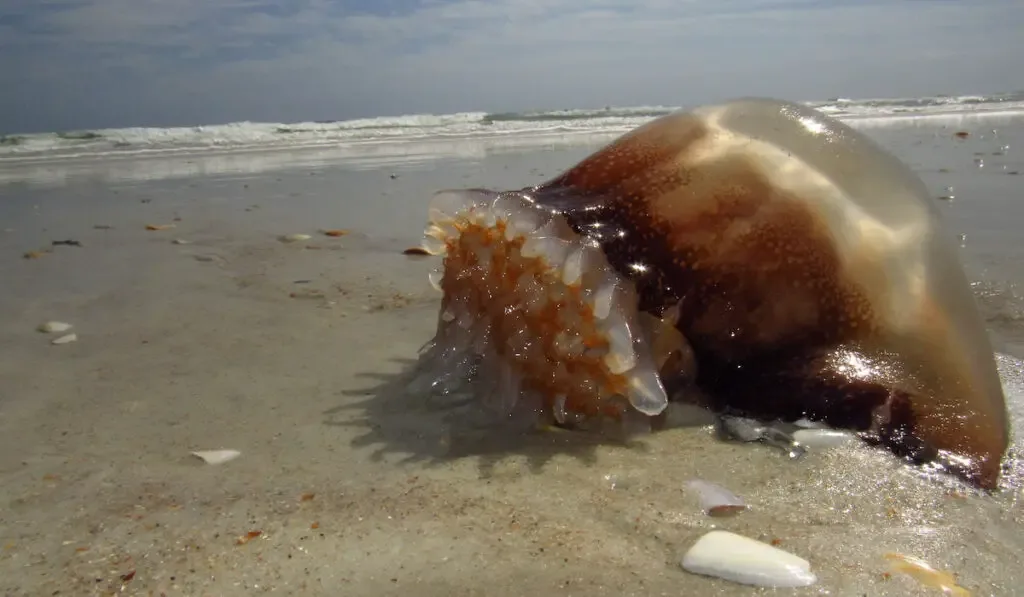
This jellyfish’s name comes from its cannonball shape and size.
Its diameter is about 9.84 inches with a 5-inch height.
An adult cannonball weighs 22.8 ounces.
Cannonballs have dome-shaped bells with forked brown arms and brown or blue rims. You will find them in estuaries and coastal shorelines.
Being predatory, the cannon balls feed on fish, plankton, fish eggs, and snails.
Unlike most jellyfish which move by wind, cannonballs use their oral arms for swimming.
When frightened, they dive deeper into the waters, releasing toxins to drive predators away and numb their prey.
This jellyfish venom causes irritation and myocardial conduction problems but is not fatal to humans. To avoid these toxin effects, avoid touching cannonballs until they are dry.
10. Comb Jellyfish
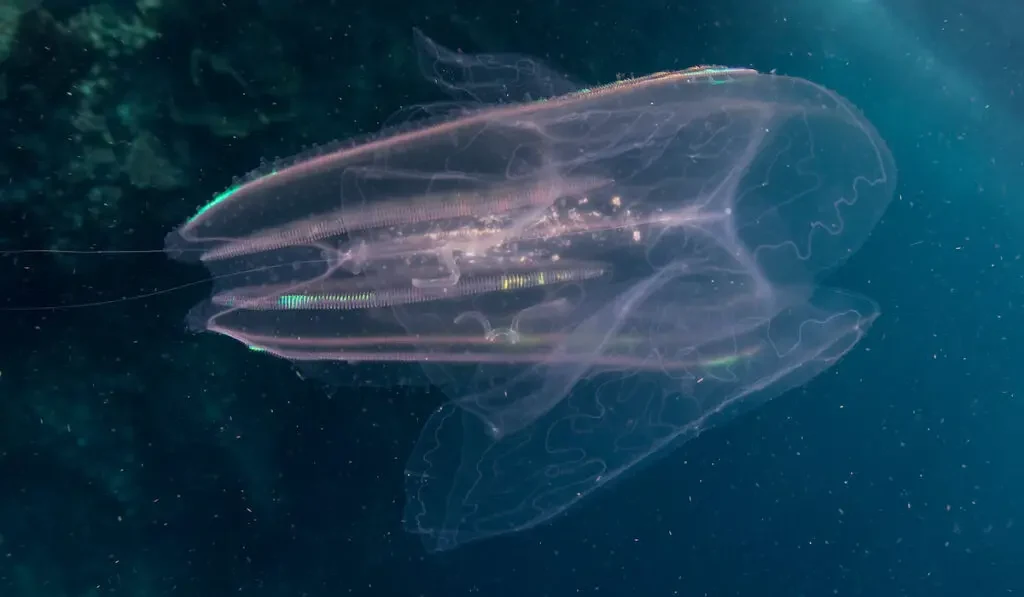
Comb jellies are famous for paddling combs and rainbow-like colors. They have plates of cilia that resemble combs.
When light illuminates these jellies, they look like a rainbow.
Most of them have one pair of tentacles, each being branched. This creates an illusion of many tentacles.
The comb jelly tentacles do not sting. Instead, they use them to trap and catch their prey.
Since they don’t sting, comb jellies are harmless to humans. You can touch them and swim with them.
11. Mauve Stinger
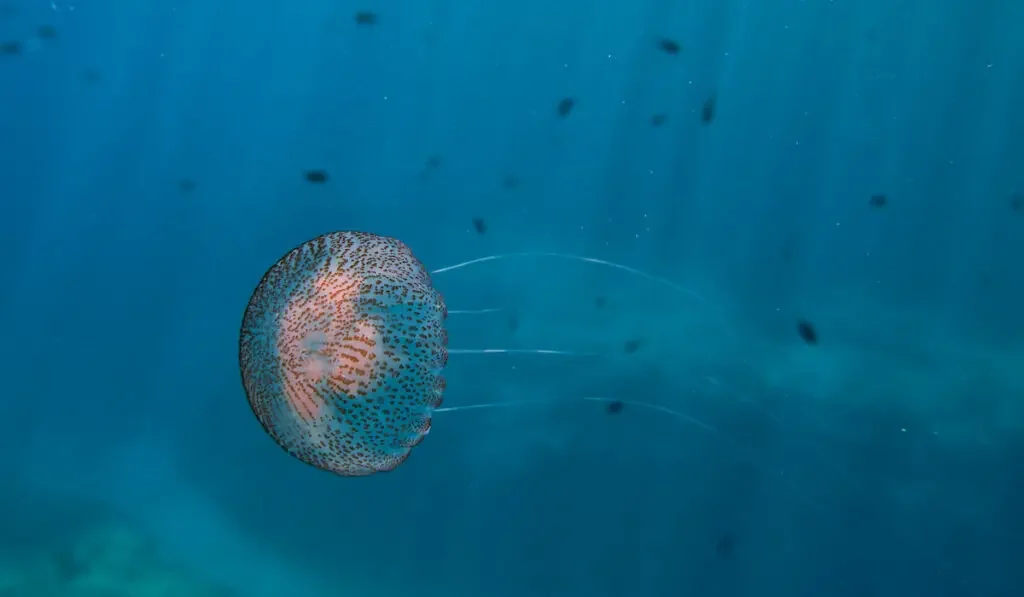
You can describe the mauve stinger in three words: small but powerful.
This small jellyfish has long tentacles, and oral arms full of stinging cells.
The mauve stinger jelly is bluish-purple with a globe-shaped bell. It has an orange rim with long thin tentacles hanging from the bell.
Mauve stingers adapt well in warm waters. And if you disturb its habitat at night, it glows.
If this jelly stings you, you will experience long-term pain and develop a scar. Their venom also causes a burning sensation and peels off your skin. However, the stings are not fatal.
Jellyfish Stings Protective Measures and Treatment
Most jellyfish stings are painful but not fatal. However, some can cause death.
The following protective measures are helpful in preventing and countering their effect.
- Pluck the tentacles from the victim carefully using tweezers.
- Soak the injured part in hot water (not too hot to cause scalds).
- Apply 1% hydrocortisone cream twice daily.
For extreme cases, seek medical attention.
Here are three types of treatment for jellyfish sting victims.
| Treatment type | Details |
| Emergency care | The patient receives resuscitation and anti-venom medicine. |
| Oral medicine | The patient receives pain relievers and antihistamine. |
| Eye flushing | The patient stung near the eye receives eye flushing for protection of the eye. |
Parting Shot
There are many types of jellyfish in Florida, each with their unique features. Although most are not dangerous to humans, some have lethal venom.
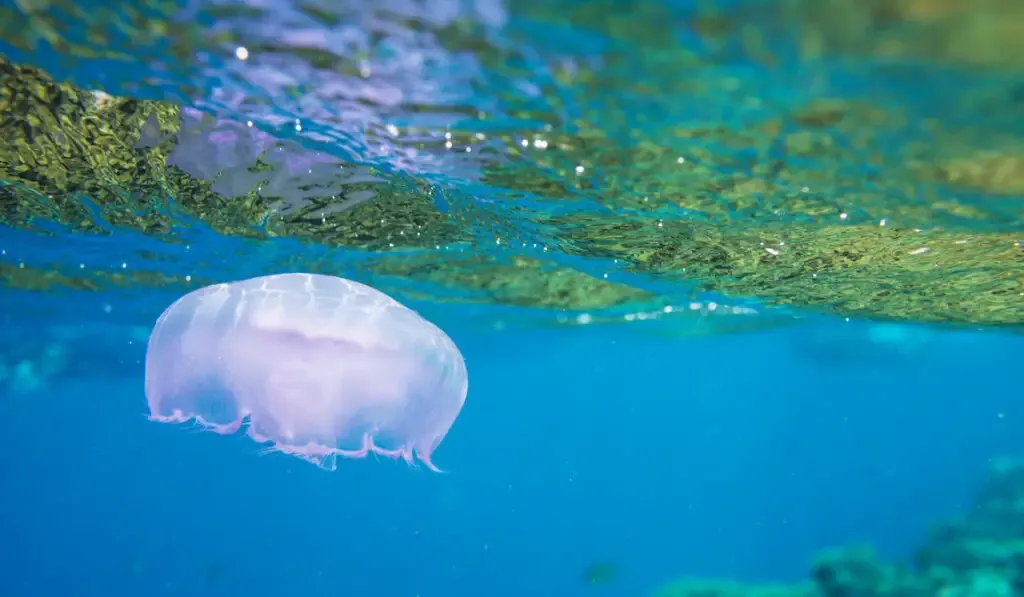
Therefore, take precautions when exploring the marine environment to avoid falling victim to venomous jellies.
You should also visit the water bodies during seasons when the different jellies thrive for an adventurous tour.
Resources
- https://www.nationalgeographic.com/animals/invertebrates/facts/box-jellyfish
- https://www.thoughtco.com/blue-button-jelly-porpita-porpita-2291819
- https://www.dimensions.com/element/pink-meanie-jellyfish-drymonema-larsoni
- https://www.youtube.com/watch?v=eLZ48fSQRa0
- https://www.roselinde.me/facts-about-moon-jellyfish/
- https://www.wildlifetrusts.org/wildlife-explorer/marine/colonial-creatures/wind-sailor
- https://www.aquariumofpacific.org/onlinelearningcenter/species/atlantic_sea_nettle1
- https://www.wildlifetrusts.org/wildlife-explorer/marine/jellyfish/lions-mane-jellyfish
- https://www.thoughtco.com/cannonball-jellyfish-4770889
- https://ocean.si.edu/ocean-life/invertebrates/jellyfish-and-comb-jellies
- https://www.wildlifetrusts.org/wildlife-explorer/marine/jellyfish/mauve-stinger
- https://www.worldatlas.com/articles/how-many-species-of-jellyfish-are-there.html
- https://www.americanoceans.org/species/portuguese-man-o-war/
- https://www.diversdirect.com/w/florida-jellyfish-to-look-out-for
- https://www.mayoclinic.org/diseases-conditions/jellyfish-stings/diagnosis-treatment/drc-20353290
